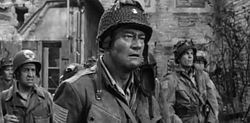Top Qs
Timeline
Chat
Perspective
John Wayne filmography
From Wikipedia, the free encyclopedia
Remove ads
American actor, director, and producer John Wayne (1907–1979) began working on films as an extra, prop man and stuntman, mainly for the Fox Film Corporation. He frequently worked in minor roles with director John Ford and when Raoul Walsh suggested him for the lead in The Big Trail (1930), an epic Western shot in an early widescreen process called Fox Grandeur, Ford vouched for him.[a] Wayne's early period as a star would be brief. Fox dropped him after only three leads. He then appeared in a string of low-budget action films (mostly Westerns) before garnering more recognition with the 1939 film Stagecoach.

During the 1940s and early 1950s, Wayne starred in Dark Command (1940), Reap the Wild Wind (1942), Wake of the Red Witch (1948), Fort Apache (1948), She Wore a Yellow Ribbon (1949), Rio Grande (1950), and Red River (1948). Some of his more notable war movies include Flying Tigers (1942), The Fighting Seabees (1944), They Were Expendable (1945), and Sands of Iwo Jima (1949), for which he was nominated for an Academy Award for Best Actor.
The 1950s saw Wayne star in an Ireland-set romantic comedy The Quiet Man (1952) and two westerns, The Searchers (1956) and Rio Bravo (1959). Wayne also continued his producing activities during this period, and formed his own production company, Batjac. During the 1960s and 1970s, Wayne starred in more Westerns, such as The Comancheros (1961), The Man Who Shot Liberty Valance (1962), El Dorado (1966) and True Grit (1969), in which his role as Rooster Cogburn earned him an Academy Award for Best Actor. He would reprise that role in the 1975 film Rooster Cogburn. He also appeared in several war films, including The Longest Day (1962) and In Harm's Way (1965).
Wayne starred in his final film, The Shootist in 1976, ending his acting career of 50 years, 169 feature length films,[2] and various other television appearances or voice-overs.
Remove ads
Filmography
Wayne in The Big Trail (1930)
Wayne in Riders of Destiny (1933)
Wayne in The Star Packer (1934)
Betty Field and Wayne in The Shepherd of the Hills (1941)
Gail Russell and Wayne in Wake of the Red Witch (1948)
Publicity photo of Wayne and Nancy Olson for Big Jim McLain (1952)
Publicity photo of Wayne and Maureen O'Hara for The Quiet Man (1952)
Wayne in The Comancheros (1961)
Wayne with James Stewart in The Man Who Shot Liberty Valance (1962)
Wayne as Lt. Colonel Benjamin H. Vandervoort in The Longest Day (1962)
Wayne with photographer Lothar Winkler on the set of In Harm's Way (1964)
As actor
As himself
Wayne with Lucille Ball in I Love Lucy, 1955
Wayne with Ball in The Lucy Show, 1966
Remove ads
As producer only
Remove ads
Box office popularity
Summarize
Perspective
Results from Quigley's Motion Picture Herald annual poll of film exhibitors would determine the year's "Top Ten Stars". John Wayne appeared on the list every time between 1949 and 1973 with one exception – 1958 – indicating that he was one of cinema's most durable stars.[259]
Remove ads
Notes
- "The tall, commanding figure of the prop boy looked right for the part and, when John Ford vouched for Wayne's dedication to work, [Raoul] Walsh arranged a screen test."[1]
Remove ads
Sources
- Boswell, John; David, Jay (1979). The John Wayne Album. New York: Ballantine Books. ISBN 978-0345280886.
- Eyles, Allan (1979). John Wayne. New York: A.S. Barnes & Co. ISBN 978-0498025907.
- Fagen, Herb (2003). The Encyclopedia of Westerns. New York: Facts On File. ISBN 978-0816044566.
- Landesman, Fred (2004). The John Wayne Filmography. Jefferson, NC: McFarland. ISBN 978-0786432523.
Remove ads
References
External links
Wikiwand - on
Seamless Wikipedia browsing. On steroids.
Remove ads














